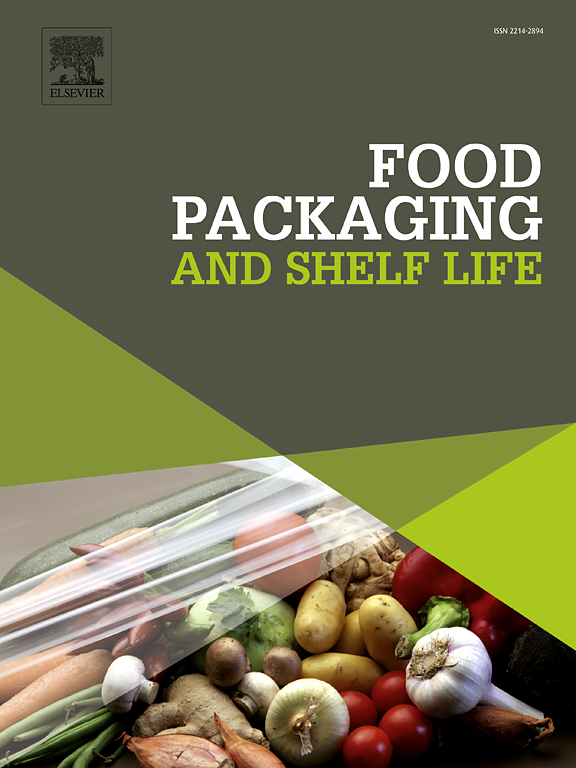Eugenol-loaded functionalized TiO₂-reinforced chitosan-guar gum-based films with photocatalytic sterilization for active food packaging application
IF 8.5
1区 农林科学
Q1 FOOD SCIENCE & TECHNOLOGY
引用次数: 0
Abstract
A biodegradable food packaging film was fabricated using nano ZnO/Nitrogen-Doped nano TiO₂ and Eugenol composite (ZTE), by incorporating different concentrations of ZTE into chitosan guargum (CG/ZTE) films. Compared to pure CG films, the nanocomposite films showed improved tensile strength, thermal stability, moisture resistance, and excellent UV shielding properties. In normal condition, the composite film exhibited excellent antibacterial activity in multiple bacterial strains such as E. coli, P. aeruginosa, S. aureus and B. subtilis. However, when irradiated under 450 nm visible light, the films showed strong antibacterial activity against S. aureus and E. coli within 30 min via photo-catalytically produced reactive oxygen species (•OH). The nanocomposite film inhibited biofilm formation by over 94 % against S. aureus and 88 % against E. coli within 72 h. The shelf-life of wrapped chicken fillets in CG/ZTE films was extended to 12 days when sterilized under visible light, compared to 6 days for unwrapped fillets. The weight loss of the composite film was more than 50 % in soil within 30 days. It showed excellent biocompatibility with L929 cells, making them suitable for food contact applications. Therefore, the composite film possessed all the desired features to be considered an active biodegradable food packaging material for industrial use.
丁香酚负载功能化tio2增强壳聚糖-瓜胶基膜光催化杀菌活性食品包装应用
将不同浓度的中兴掺入壳聚糖(CG/ZTE)薄膜中,以纳米ZnO/氮掺杂纳米TiO 2和丁香酚复合材料(ZTE)制备可生物降解的食品包装膜。与纯CG膜相比,纳米复合膜具有更好的抗拉强度、热稳定性、抗湿性和优异的紫外线屏蔽性能。在正常条件下,复合膜对大肠杆菌、铜绿假单胞菌、金黄色葡萄球菌和枯草芽孢杆菌等多种细菌均具有良好的抑菌活性。然而,当在450 nm可见光下照射时,该薄膜通过光催化产生的活性氧(•OH)在30 min内对金黄色葡萄球菌和大肠杆菌表现出较强的抗菌活性。在72 h内,纳米复合膜对金黄色葡萄球菌和大肠杆菌的生物膜的抑制率分别为94% %和88% %。CG/ZTE薄膜包装的鸡肉片在可见光下灭菌后保质期延长至12天,而未包装的鸡肉片仅为6天。复合膜在土壤中30 d失重大于50% %。它与L929细胞表现出良好的生物相容性,使其适合于食品接触应用。因此,复合薄膜具有被认为是工业用途的活性生物可降解食品包装材料的所有所需特征。
本文章由计算机程序翻译,如有差异,请以英文原文为准。
求助全文
约1分钟内获得全文
求助全文
来源期刊

Food Packaging and Shelf Life
Agricultural and Biological Sciences-Food Science
CiteScore
14.00
自引率
8.80%
发文量
214
审稿时长
70 days
期刊介绍:
Food packaging is crucial for preserving food integrity throughout the distribution chain. It safeguards against contamination by physical, chemical, and biological agents, ensuring the safety and quality of processed foods. The evolution of novel food packaging, including modified atmosphere and active packaging, has extended shelf life, enhancing convenience for consumers. Shelf life, the duration a perishable item remains suitable for sale, use, or consumption, is intricately linked with food packaging, emphasizing its role in maintaining product quality and safety.
 求助内容:
求助内容: 应助结果提醒方式:
应助结果提醒方式:


